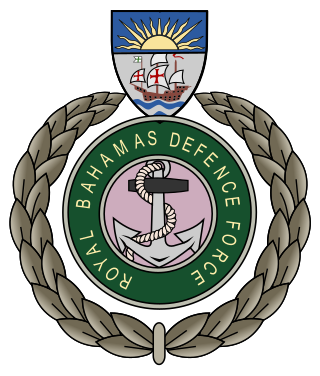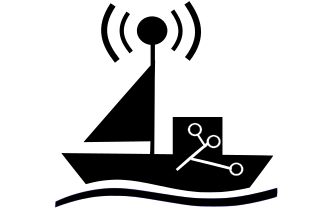Related Research Articles
Scout may refer to:

A remote-control vehicle is defined as any vehicle that is teleoperated by a means that does not restrict its motion with an origin external to the device. This is often a radio-control device, a cable between the controller and the vehicle, or an infrared controller.

A survey vessel is any type of ship or boat that is used for underwater surveys, usually to collect data for mapping or planning underwater construction or mineral extraction. It is a type of research vessel, and may be designed for the purpose, modified for the purpose or temporarily put into the service as a vessel of opportunity, and may be crewed, remotely operated, or autonomous. The size and equipment vary to suit the task and availability.

Kaikō was a remotely operated underwater vehicle (ROV) built by the Japan Agency for Marine-Earth Science and Technology (JAMSTEC) for exploration of the deep sea. Kaikō was the second of only five vessels ever to reach the bottom of the Challenger Deep, as of 2019. Between 1995 and 2003, this 10.6 ton unmanned submersible conducted more than 250 dives, collecting 350 biological species, some of which could prove to be useful in medical and industrial applications. On 29 May 2003, Kaikō was lost at sea off the coast of Shikoku Island during Typhoon Chan-Hom, when a secondary cable connecting it to its launcher at the ocean surface broke.

Unmanned underwater vehicles (UUV), also known as uncrewed underwater vehicles and underwater drones, are submersible vehicles that can operate underwater without a human occupant. These vehicles may be divided into two categories: remotely operated underwater vehicles (ROUVs) and autonomous underwater vehicles (AUVs). ROUVs are remotely controlled by a human operator. AUVs are automated and operate independently of direct human input.

The Royal Bahamas Defence Force (RBDF) is the military of The Bahamas. Since The Bahamas does not have an army or an air force, its navy composes the entirety of its armed forces. Under The Defence Act, the Royal Bahamas Defence Force has been mandated to defend The Bahamas, protect its territorial integrity, patrol its waters, provide assistance in times of disaster, maintain order in conjunction with the law enforcement agencies of The Bahamas, and carry out any such duties as determined by the National Security Council. The Defence Force is also a member of CARICOM's Regional Security Task Force. The task force has seen action in the United Nations mandate in Haiti 1994.

An unmanned surface vehicle, unmanned surface vessel or uncrewed surface vessel (USV), colloqually called a drone boat, drone ship or sea drone, is a boat or ship that operates on the surface of the water without a crew. USVs operate with various levels of autonomy, from remote control to fully autonomous surface vehicles (ASV).

Yankee is an early-20th-century steel hulled ferry which is registered as a historic vessel with the National Register of Historic Places. As of 2006 it was berthed in Hoboken, New Jersey. In mid-2013, the ferry was moved to the Henry Street pier in the Gowanus Bay Terminal in Red Hook, Brooklyn.
Richard Jenkins is a 47 year old engineer from Lymington, UK. He is known for engineering and sailing wind-driven vessels on land, ice, and water. In 1999, he founded the Windjet Project while studying mechanical engineering at Imperial College. Since then he has designed, built, and tested four separate speed record craft. Jenkins is currently the founder and CEO of Saildrone, a company that designs, manufacturers, and manages unmanned surface vehicles that sail the world's oceans collecting science data. In 2019, SD 1020 became the first unmanned vehicle to complete a circumnavigation of Antarctica, crossing every longitude line in the Southern Ocean.

The ASW Continuous Trail Unmanned Vessel (ACTUV) is a DARPA funded project launched in early 2010 to develop an anti-submarine drone. ASW is an acronym for Anti-Submarine Warfare. In January 2018 after successful sea trials it was announced that the "Sea Hunter" prototype has transitioned from DARPA to the Office of Naval Research for further development.
Liquid Robotics is an American marine robotics corporation that designs, manufactures and sells the Wave Glider, a wave and solar powered unmanned surface vehicle (USV). The Wave Glider harvests energy from ocean waves for propulsion. With this energy source, Wave Gliders can spend many months at a time at sea, collecting and transmitting ocean data.

LÉ Samuel Beckett (P61) is a Samuel Beckett-class offshore patrol vessel (OPV) of the Irish Naval Service. The ship was launched in November 2013 and commissioned in May 2014. She is named after Irish playwright and author Samuel Beckett.

Wind power in Rhode Island is in the early stages of development. There are several small scale wind turbine projects in the state. As of December 2013 there were 11 turbines at 10 sites in the state. In 2014, Rhode Island had 9 MW of installed wind power capacity, which quickly rose to 75 MW in 2019.

Buffalo Automation is an artificial intelligence (AI) startup that develops autonomous navigation technology for commercial ships, recreational boats, and water taxis with the goal to improve maritime safety. It is a private company based in Buffalo, New York. Thiru Vikram is the CEO of the company.
USV Maxlimer is a semi-autonomous, remotely controlled unmanned surface vehicle (USV) owned and operated by the British company SEA-KIT International. She was the winning entry in the Shell Ocean Discovery X Prize competition, and subsequently has been used as a proof-of-concept vessel for uncrewed, over-the-horizon offshore operations.
In April 2018, the Dutch Government approved a multi-year investment program for the Dutch Navy and allocated funds for the 2018–2030 period. The Dutch Defence Materiel Administration (DMO) is in charge of the procurement of these new ships.

Mayflower AI sea drone, or Mayflower Autonomous Ship, or Mayflower 400 (MAS400) is an autonomous research vessel that aims to cross the Atlantic without human crew or assistance. It is named after the Mayflower sailing ship, that carried English and Dutch Pilgrims onboard from England to New England between September and November 1620. Taking the same route, it was originally intended to set sail in September 2020 in time for the 400th anniversary.
Sea Machines Robotics is a Boston, MA-based startup that is developing autonomous control and navigation systems for the commercial marine and boating industries.
Saildrone, Inc. is a United States company based in Alameda, California, that designs, manufacturers, and operates a fleet of unmanned/uncrewed surface vehicles (USVs), or ocean drones, known as "saildrones". The company was founded by engineer Richard Jenkins in 2012.
References
- 1 2 Pete Danko (July 10, 2013). "'Scout,' Robotic Solar Boat, On Transatlantic Voyage Thanks To Group Of College Students". The Huffington Post . Retrieved September 1, 2013.
- 1 2 3 Bruce Burdett (June 4, 2013). "From Tiverton — A slow boat to Spain". EastBayRI . Retrieved September 1, 2013.
- ↑ Richard Salit (July 10, 2013). "Student designers end boat's second bid to cross from RI to Spain". The Providence Journal . Retrieved September 1, 2013.
- ↑ Richard Salit (August 24, 2013). "Autonomous vessel Scout makes 3rd transatlantic bid". The Providence Journal . Retrieved September 1, 2013.
- ↑ "Students build unmanned boat that's crossing the Atlantic right now". MSN . August 31, 2013. Archived from the original on September 1, 2013. Retrieved September 1, 2013.
- 1 2 Richard Salit (June 2, 2013). "R.I. sailing buddies build solar-powered robot boat for trip to Spain". The Providence Journal . Retrieved September 1, 2013.
- ↑ "The Build". goscout.com. Retrieved September 1, 2013.